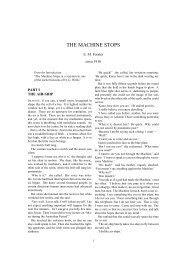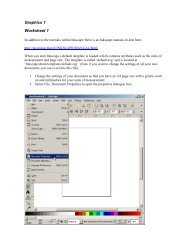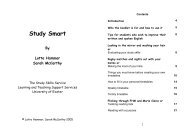PDF - The Metaphysics of Virtual Reality - University of Exeter
PDF - The Metaphysics of Virtual Reality - University of Exeter
PDF - The Metaphysics of Virtual Reality - University of Exeter
Create successful ePaper yourself
Turn your PDF publications into a flip-book with our unique Google optimized e-Paper software.
<strong>The</strong> computer opponent line takes for its paradigm the chess match. More combative<br />
than the Turing test, the chessboard places the human in a duel with the computer, the<br />
winner claiming superior intelligence. <strong>The</strong> game paradigm ensures that the relationship<br />
remains antagonistic. <strong>The</strong> combative paradigm still holds sway over the popular<br />
imagination, the human-versus-the-machine contest, with a winner/loser outcome.<br />
Dreyfus first connected Heidegger with computers by working within this model.<br />
Observing an unbounded enthusiasm for artificial-intelligence research, Dreyfus drew<br />
on Heidegger’s critique <strong>of</strong> technology to set limits on the kind <strong>of</strong> research that defines<br />
the human mind as an information processor. Dreyfus challenged the very idea that a<br />
chessplaying program "<strong>of</strong> any significance" could be built, and in 1965 he published a<br />
paper equating "Alchemy and Artificial Intelligence." This ruffled the AI researchers,<br />
and they took Dreyfus up on his challenge. In 1967, MIT researchers confronted Dreyfus<br />
with a computer chess program named MacHack. To the delight <strong>of</strong> the AI community,<br />
Dreyfus lost to the computer in a public match. 7 Later, in What Computers Can’t<br />
Do, Dreyfus explained his philosophical point-that he was concerned not with generic<br />
predictions but with the underlying comparison that hastily identifies intelligence with<br />
formal patterns or algorithms.<br />
Dreyfus sharpened Heidegger’s technology critique by focusing on the formal patterns<br />
that computers use. Because s<strong>of</strong>tware programs run by explicitly stated instructions,<br />
the computer works on a level <strong>of</strong> intelligibility that Heidegger characterized as<br />
derived and not primordial. Formal patterns process reality but filter it through the<br />
screen <strong>of</strong> lucidity. What fails to fit the patterns gets lost in the process, even if we try<br />
to reintroduce the unknown into our interpretations. <strong>The</strong> tendency to interpret reality<br />
as essentially lucid or representable goes back to Plato, according to Heidegger’s early<br />
reading <strong>of</strong> Plato. 8 Dreyfus sees in the computer, according to artificial intelligence<br />
researchers, the apotheosis <strong>of</strong> metaphysics. Plato postulated the Good as subsistent in<br />
itself. <strong>The</strong> Good, the agathon, energizes the forms <strong>of</strong> things, making them stable<br />
7 <strong>The</strong> history <strong>of</strong> this chess match appears in Howard Rheingold, Tools for Thought: <strong>The</strong> People and<br />
Ideas Behind the Next Computer Revolution (New York: Simon and Schuster, 1985), pp. 161-62. Dreyfus<br />
explains what he takes to be the point <strong>of</strong> the match in Mind over Machine (p. 112).<br />
8 Martin Heidegger, "Platons Lehre van der Wahrheit," in Wegmarken, pp. 109-44. This was a lecture<br />
series given in 1930 and 1931.<br />
59
















